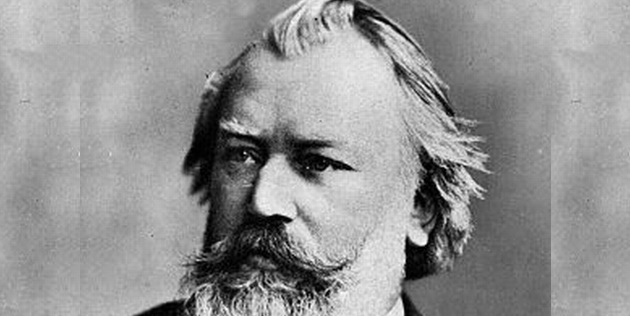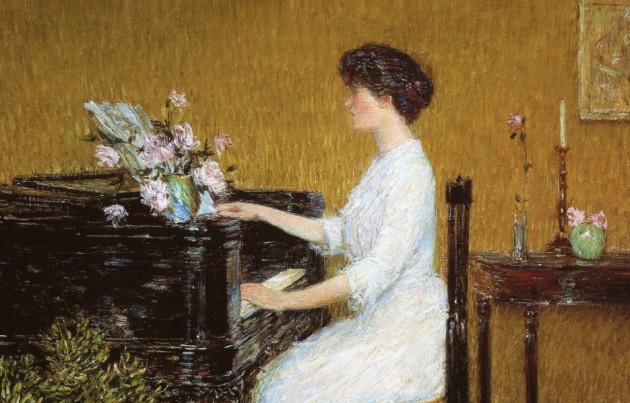Echo Chamber
Brahms’ hesitance to engage in orchestral writing had another unintended effect – he produced a huge amount of chamber music. But it wasn’t just the number of pieces which was impressive, it was their invariably high quality. Almost no one apart from Schubert put quite so much effort into pieces of this kind. His perfectionism manifested itself here just as much as anywhere else – Brahms claimed to have destroyed more than twenty string quartets before he felt happy to publish one, which is perhaps understandable for a man who kept a bust of Beethoven above his piano. But all the ruthless revision of his own work paid off, because practically all his chamber music is worth hearing. Listening to them in full would take you about twelve hours, so I’ve saved you the trouble by selecting some particularly great extracts. Let’s start with what is quite possibly my favourite piece of chamber music. It’s hard to think of many pieces quite as staggeringly beautiful as this one, or any which pack so much emotional weight into simple, but pleasing, phrases:
Piano Trio No. 1 in B minor – 1st Movement, Allegro con brio:
Before moving on, it’s worth saying that whenever you see the name of an instrument in the title of a piece like this, that instrument is included in the number following it. For instance, a piano quartet is not a piano and a string quartet, the piano is the fourth instrument in the quartet. If you did put together a piano and a string quartet, you’d have a piano quintet. Make sense? No? Don’t worry. It doesn’t really matter. Next up are the piano quartets. Here’s the exuberant “gypsy” finale from the first of them, another example of Brahms’ use of folk music as a source of inspiration.
Piano Quartet No. 1 in G Minor – 4th Movement, Rondo alla Zingarese:
The third piano quartet is entirely different, starting with a slow, ominous introduction before cascading downwards into a dramatic, pulsating sequence. Eventually things calm down again, but from about 9:30 onwards there is an incredible, unexpected outburst. The utterly brilliant work of Stephen Malinowski, who recently collaborated with Björk to produce animations for Biophilia, comes in handy here for showing you exactly how this piece is put together. If you’re interested, he’s also made an animation of the slow movement from this quartet.
Piano Quartet No. 3 in C Minor – 1st Movement, Allegro non troppo:
Another of my personal favourites, the jittery and, for the French horn player, extremely challenging, finale to the Horn Trio.
Horn Trio in Eb Major – 4th Movement, Finale – Allegro con brio:
Brahms also wrote material for strings alone, in the form of both quintets and sextets. In less capable hands, this limited palette of sounds can become monotonous, or overly complicated because of the number of parts, but Brahms avoided both of these pitfalls thanks to his sensitive approach to the particular timbre of string instruments and his brilliant layering. Here are a couple of highlights – the fugal finale of the first quintet, and the slightly deranged scherzo from the second sextet:
String Quintet No. 1 in F Major – 3rd Movement, Allegro energico, presto:
String Sextet No. 2 in G major – 2nd Movement, Scherzo, allegro non troppo:
On an even more intimate scale are Brahms’ violin and cello sonatas. While technically brilliant, it is once again the sheer emotional content on offer which makes them stand out. These extracts from the cello sonatas range from the mysterious and elusive to mournful proto-jazz. As a side note, the cellists here are two titans of the instrument – Mstislav Rostropovich and Jacqueline du Pré.
Cello Sonata No. 1 in E Minor – 1st Movement, Allegro non troppo:
Cello Sonata No. 2 in F Minor – 2nd Movement, Adagio affetuoso:
The violin sonatas are equally varied – the first is the most popular, but I think the frenetic, helter-skelter finale to the third puts it ahead of the other two. The violinist here is the brilliant Anne-Sophie Mutter.
Violin Sonata No. 1 in G Major – 1st Movement, Vivace ma non troppo:
Violin Sonata No. 3 in D Major – 4th Movement, Presto agitato:
Towards the end of his life, during a party at Clara Schumann’s house, Brahms admitted to his friend and hostess that he had largely given up creating music for the public, and now wrote only for himself, if he wrote at all. Not long afterwards, however, he encountered a young clarinettist named Richard Mühlfeld, whose playing furnished the ageing composer with new inspiration. Not since the days of Mozart and Weber had anyone written much substantial new material for the clarinet, so Brahms’ music for the instrument were unexpected delights in a century which had become clogged with ostentatious violinists and pianists. Brahms responded brilliantly to the bittersweet, autumnal tones of the clarinet in a number of pieces. The best known of these is the Clarinet Quintet, which is utterly different from works of the same kind that had come before, and is regarded by many as one of his greatest works. It’s also one of his most soothing pieces – like sonic coughdrops.
Clarinet Quintet in B Minor – 2nd Movement, Adagio:
There are also a couple of slightly more lively pieces for clarinet, including a trio and two sonatas, the second of which contains one of Brahms’ most inspired melodies.
Clarinet Trio in A Minor – 4th Movement, Allegro:
Clarinet Sonata No. 2 in E Minor – 2nd Movement, Allegro appassionato:
I haven’t included huge amounts of chamber music on the spotify playlist, but hopefully the bits I have provided will allow you to explore this area of Brahms’ output for yourself.
Zitto Zitto, Piano Piano
Count Basie once wrote a tune called “Splanky” as a riposte to the nickname his band had given him and his style of playing, and I think that’s a good way to describe Brahms’ piano writing too, since he often produced a spectacular, chunky chord sequence, seemingly from nowhere. Brahms’ solo piano music includes three sonatas, several sets of variations and a wealth of miniature pieces. Beethoven and Schubert had more or less killed the piano sonata, exhausting its possibilities relatively early on. Yes, Chopin, Schumann and Liszt all made their contributions, but most people stayed well clear of the genre for the rest of the century. The piano sonata as a form never really seemed to suit Brahms particularly well, and lighter works like his Opus. 39 Waltzes were more popular, and deservedly so. It wasn’t until his final years that Brahms found a form which truly complemented his style. They went by various names – Klavierstücke, Intermezzi, Fantasies, Rhapsodies, Ballades, Caprices and so on, but all were united by their fairly short duration – usually five minutes or less – and a prevailing mood of introspection and wistfulness. They are deeply personal and structurally innovative; some almost dissolve in an impressionistic blur of sound while others erupt like symphonies condensed into a single instrument. They sound like fragments or improvisations, but were in fact meticulously assembled. They avoid the showmanship of Liszt or Chopin but are nonetheless extremely difficult to play. There are 28 altogether, but these are some of my favourites, starting with a piece which sounds suspiciously like jazz…
Klavierstücke Op. 119 – Intermezzo No. 3 in C Major – Grazioso e giocoso:
Klavierstücke Op. 76 – Capriccio No. 2 in B Minor:
Fantasien Op. 116 – Intermezzo No. 2 in A Minor:
Intermezzi Op. 117 – No. 1 in Ab major – Andante moderato:
Intermezzi Op. 117 – No. 2 in Bb minor – Andante non troppo:
Klavierstücke Op. 118 – Intermezzo No. 2 in A major – Andante teneramente:
Klavierstücke Op. 118 – Ballade No. 3 in G Minor – Allegro energico:
Klavierstücke Op. 119 – Intermezzo No. 2 in E Minor – Andantino:
Klavierstücke Op. 119 – Rhapsodie No. 4 in Eb Major – Andantino:
And that’s everything. A complete Brahms survey. What’s that? You want to hear some more Hungarian Dances? And you want them to accompany a classic Looney Tunes cartoon? Well… I’ll see what I can do…
Oh, and you want to hear an unbelievably bad recording of Brahms’ voice and piano playing from an 1880s wax cylinder? No problem…
Previous Classicals:
#1: Roll Over Beethoven: An Introduction to Beethoven
#2: Rock Me Amadeus: An Introduction to Mozart
#3: Tch-Tch-Tch Tchanges: An Introduction to Tchaikovsky
#4: Schubert Dip: An Introduction to Schubert
#5: Bach to the Future: An Introduction to Bach


